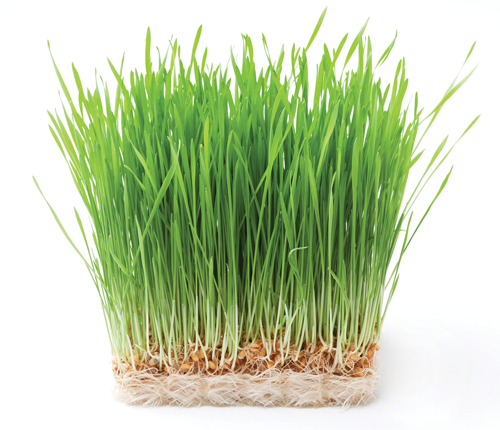
By Kristy Podruchny
Wheatgrass has proven itself to be a powerful food in the fight against cancer, obesity, high cholesterol, and many other ailments. It has earned the title “super food” because wheatgrass is packed with vitamins, minerals, essential amino acids and antioxidants. You can enjoy wheatgrass by drinking its juice, mixing freeze-dried powder into food or drinks, or taking a capsule. Health food stores and juice vendors sell trays of live grass, seeds, juice, powder, and supplements. The taste of the juice varies, but its usually has a light, sweet, and earthy flavor. Some people love the flavor right away and others find it to be an acquired taste.
People usually remark at wheatgrass’ deep green color. That’s chlorophyll you’re looking at! Wheatgrass is 70 percent chlorophyll, or “green blood.” Chlorophyll is efficient in transporting oxygen and contains anti-inflammatory properties. Chlorophyll has piqued interest in studies conducted on cancer prevention and treatment.
A 2017 study published in the Journal of Clinical and Diagnostic Research points out the similarities between hemoglobin (the protein molecule in charge of the transport of oxygen in red blood cells) and chlorophyll. Cancer cells are susceptible to high levels of oxygen, so efficient oxygen transport is essential in cancer treatment and prevention. Another weapon in wheatgrass’ arsenal is its alkalinity and high levels of antioxidant enzymes that combat DNA-damaging free radicals.
Wheatgrass contains appetite-suppressing thylakoids. You can find thylakoids in all green leaves. Thylakoid supplementation affected appetite hormones in rats in a study published by BMC in 2016. The study suggests thylakoids can play an important role in treating and preventing obesity.
This potent super food is best consumed right after juicing. Cooking the grass or juice breaks down beneficial enzymes contained in wheatgrass. Juicing extracts living chlorophyll, enzymes, and nutrients you lose through digesting the grass. Try adding coconut water if you’re getting used to the taste.
It’s important to proceed with caution if you have celiac disease or are sensitive to gluten. Wheatgrass doesn’t contain gluten because it’s not a mature wheat plant with seeds, but contact with seeds, mature grass, or contamination at supplement facilities could put you at risk. Check with a medical professional before you try wheatgrass if you have any issues with gluten.
Go ahead and start your own wheatgrass garden. You might want to grow an extra tray for your cat to munch on, too! Don’t hesitate to incorporate this interactive super food into your daily routine.
Cancer cells are susceptible to high levels of oxygen, so efficient oxygen transport is essential in cancer treatment and prevention.



